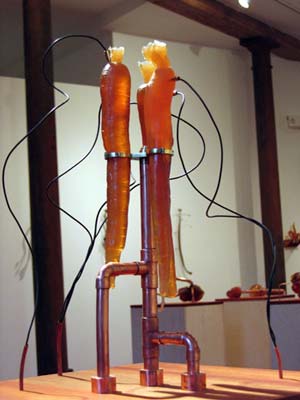A quick Google search of the phrase genetically modified vegetables produces a wide range of interesting results. They run the gamut from the practical (What are the labelling requirements for genetically modified food?) to optimistic (Genetically Modified Rice Could Save Hundreds of Millions of Lives) to the vaguely paranoid (How to Avoid Genetically Modified Foods) to the completely paranoid (Soon we will all be genetically modified vegetables). Given how modified foods dominate our marketplace, it is no surprise that many people have an opinion nor that many also have fears.
Bell Peppers and Other Inedibles, the new show of recent works by sculptor Ellen Wetmore, is a very playful look at some of these fears. While we all know, somewhere down deep inside, that GM foods are made in boring white labs by boring scientists who talk of boring topics like DNA strands and gamete strains, Wetmore's vision is much more fantastic and engaging. Her works show distorted carrots, cast in an amber resin and fed by electrodes; there are strangely mutated bell peppers, cast in bronze and lined with gold leaf; and there is a wall of cast carrots diverted and re-shaped by copper piping.
There are many moments in this delicately humorous show in which I wanted Wetmore to sneak up behind me and scream "It's alive! Alive!" like Doctor Frankenstein in a classic horror film. Her works almost require that level of campy mania, or at least a belief that eventually our sciences will create a race of super-vegetation capable of sustaining our lazy culture indefinitely. If we can create self-hydrating carrots or gold-leafed peppers, why not potatos that mature automatically into Pringles or apples that drop from the tree and walk to the nearest processing plant? In Wetmore's world, it seems almost possible.
Or, perhaps it is not the possiblity that is enticing, but man's constant striving to make it reality. In my opinion, Wetmore's finest work features a carrot fed by a thick electrical cord (most commonly seen on clothes dryers) that lays beside it on the pedestal. The pedestal also features the correct electrical outlet, yet the carrot is not plugged in. Is it now useless? Does it only have life or value or meaning when it is electrified, or (given the extreme voltage of the plug) is it best that this carrot remains quiet?
My other favorite piece is a thick carrot with RCA video cables growing where the greens usually reach for sunlight. Along one side of the carrot RCA plugs protrude, and several of the cables are plugged into these outlets. The whole piece seems to be a closed circuit, as if the carrot does not need any of the outside influences clearly required by the others in the room. Then again, it may just be in storage, the cords plugged in to safely keep them from twisting during travel. Is it at the height of its usefulness, or merely waiting to be attached to a television or radio and given its opportunity to shine?
Wetmore's strange bell peppers, carrots and onions are both beautiful and well-stated, a collection of works that inspired a small fear in me and yet made me laugh at that fear. They are a delicate commentary on one of the grey areas of our scientifically saturated lives, and probably answer the never-asked question "How would Jules Verne have envisioned genetically modified foods?"
Links:
Boston Sculptors Gallery
"Ellen Wetmore: Bell Peppers and Other Inedibles" is on view October 26 - November 27, 2004 at Boston Sculptors Gallery.
All images are courtesy of the artist.
Matthew Nash is the publisher of Big, Red & Shiny.



